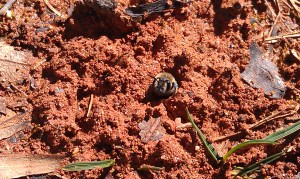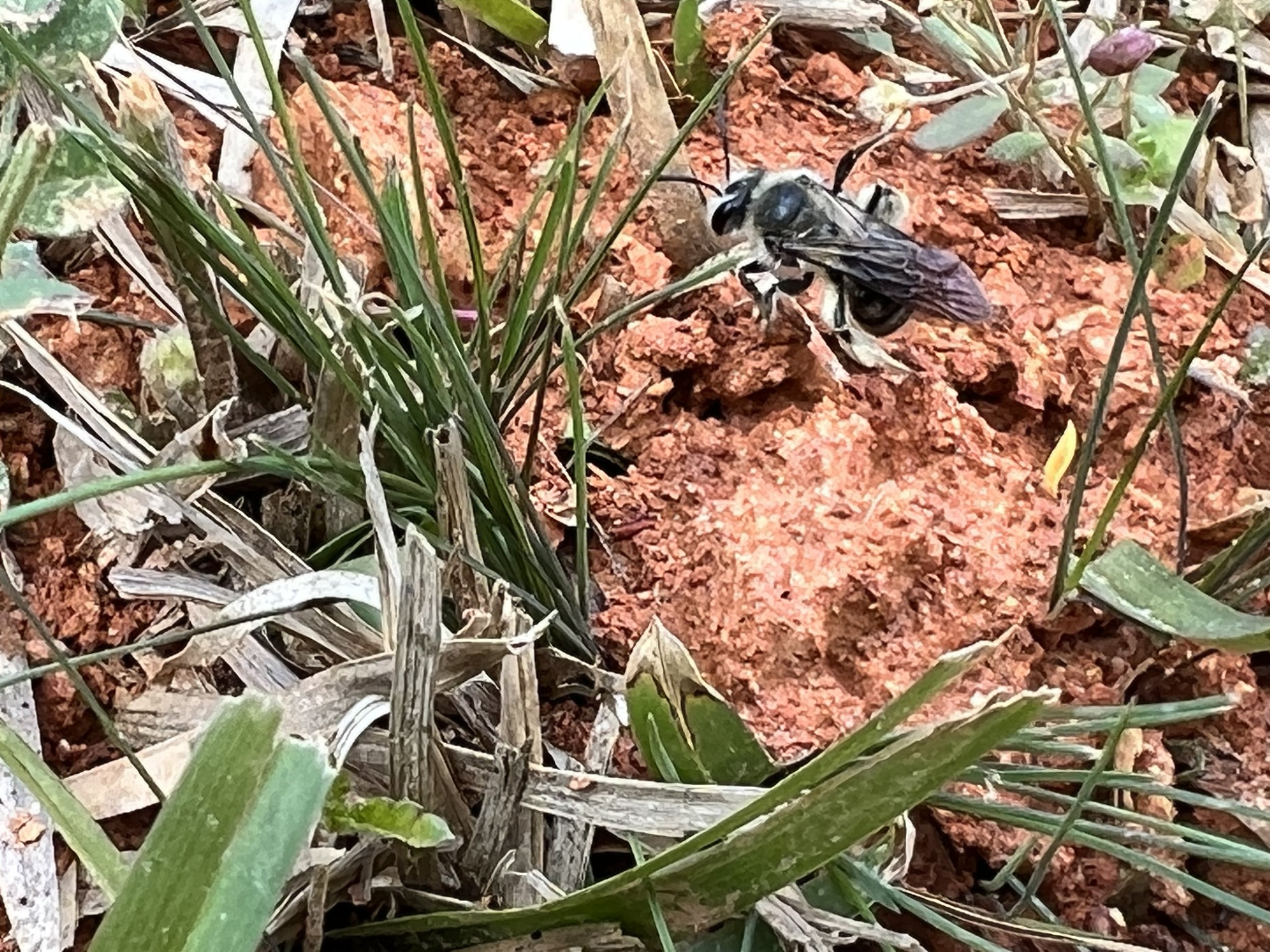Why Bees are Coming Out of the Ground
[2024 Update: I now look forward to March and anticipate when the secret trove of ground bees will emerge. And right on schedule this year, they are back. And my how they’ve expanded! If you’re noticing tiny mounds of dirt surrounding small holes in your yard, it could be these wonderful native bees. Here’s the backstory:]
How many types of bees can you name? Honeybees, bumblebees, carpenter bees... All correct, but you are just 498 short of naming all of North Carolina's native bees.
In spring, our native ground-dwelling bees appear in abundance. So, be on the lookout this time of year for these amazing creatures! Their subterranean habitat might surprise the unsuspecting homeowner -- or dog-walker. (Ask me how I know.)
Over 500 species of bees call N.C. home and do the bulk of the work pollinating our landscapes. (Honeybees aren't native to North America, but they have ancestors who were, thus, their southern buzz :). It's common for us to assume that similar-looking winged things are all the same. But there is a world of highly valuable pollinators, sometimes just beneath our feet.
I stumbled upon a huge swath of native miner bees (of the adrenid family) this week. They were busy ferrying pollen back to their underground nurseries and took no notice of me. But the sheer number of them was amazing! Each one of these tiny ant-mound look-alikes is a bee tunnel.
The Importance of North Carolina's Native Bees
With nature ready to explode in full bloom this time of year, our native bees are quite literally on parade. These largely uncelebrated bees are the pollinating workhorses of our farms and landscapes, while honeybees get all the headlines.
There's huge diversity in our native bees, but some of their valuable traits include:
Work in cooler weather
Are appropriately sized for some small flowers
Specialize in specific flowers or flower families
Adapted to some pests and diseases
Overwinter without intervention
Native Bees vs. Honeybees
Native bees are fascinating and live very different lives than their honeybee cousins. Most of our native bees are solitary or socially-flexible bees where all females lay eggs and raise young, compared to honeybee colonies with just one egg-laying queen.

Ground bee emerging from its mound. Image by NC Cooperative Extension.
About 80% of native bees live underground, sometimes alone (like a hut), often alone but in groups (apartments), and sometimes communally (one large family home). By comparison, honeybees are our most social bees, living cooperatively with a division of labor in large colonies.
Wasps vs. Native Ground Bees
Living underground can give you a bad rap.
Sadly, bees coming from the ground can be confused for a very different insect. Native ground bees are NOT yellow jackets that belong to the wasp family.
Here is the difference:
I realize it may be hard to tell them apart in the heat of the moment, but there are some notable differences:
Fuzz. Not all native bees are fuzzy, but those who live underground in large groups tend to be fairly fuzzy and kinda cute. At first glance (or any glance), they are easily confused with honeybees. In fact, many of the differentiating features of native bees require a magnifying glass to detect. So don't feel bad.
Household size. Most native bees lay only a few eggs in their dwelling. There may be many dwellings in one area, but they are usually separate families. Yellow jacket colonies can be sizable.
Entrance construction. Ground-dwelling native bees dig out small piles of dirt to form their homes. It piles up at the entrance like a tiny ant mound. Yellow jackets generally have a larger hole and don't usually pile up dirt at the entrance.
Quantity of entrances. Often, there are many (thousands!) of these entrances in a small area. Yellow jackets usually have only one or two entrances.
Defensiveness. Native bees mind their own business. In their territory, you're a source of confusion rather than a target. But this is a defining characteristic of yellow jackets. Just being in their nest area can warrant a sting. Poke the nest? Now you and your extended family are targets — forever.
Sting Probability. Native bees don't have a well-developed stinger. They can sting, but unless ruthlessly provoke, it's unlikely. Yellow jackets? They seem to sting just for kicks.
Native ground bee
A yellow jacket
Fire Ants (aka demons) vs. Ground Bees
Another sad case of mistaken identity. Ground bees are NOT fire ants (who prove Hell is real and who have a great appetite for my wrists and ankles in the flower field). The tiny, individual miner bee mounds cannot compare to the heaps of earth moved by a colony of fire ants.
Ground bees may live close to one another but generally work alone. Team fire ant responds immediately, en masse.
Since ground bee mounds are often found in clusters, it can be confusing. Let's investigate...
Fire ants = ants = large colony in a mound = goes ballistic when disturbed = pain & swearing
Miners = bees = single bees forming mounds = busy working in your yard = food/berries
Fire ant mounds
How to Encourage or Discourage Ground Bees
Native bees prefer different habitats, some like the ground, or woodpiles, or hollow stems. Ground-dwelling natives look for thin patches of grass with visible soil. And they tend to frequent the same area year after year. Knowing their importance and very low risk will hopefully encourage you to coexist and enjoy watching this native species - like hosting hummingbirds.
You can encourage ground bee populations by leaving areas of your yard unplanted, untilled/cultivated and lightly mulched. Avoid using pesticides, especially dusts that can cling to fuzzy bees like pollen. Celebrate if these flower fairies choose your yard for their home!
But if you'd rather see them mine somewhere else, you can deter ground bees (without killing important pollinators) by doing the opposite. Improve your grass density (through proper seeding and maintenance) or convert a thin, shady lawn area to a heavily-mulched planting bed. Bees are masters of efficiency. If a better habitat is available, they'll choose it.
Want to Learn More About Bees?
Start with this helpful article from the NC Cooperative Extension on the importance of ground-dwelling native bees.
Go further by joining one of our Honeybee Hive Tours. You'll learn about the differences between honeybees and native bees; the role of pollinators in agriculture and our ecosystem; and amazing facts about the uniquely social honeybee. Then, suit up for a hands-on look inside a working honeybee hive. Experience the wonder of bees!




